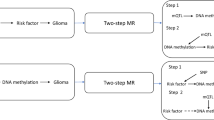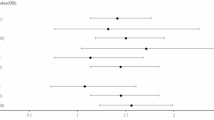Abstract
The present study performed a segregation analysis of a cohort of first-degree relatives (FDR) of glioma patients. The families with two or more gliomas were also expanded to determine if any more gliomas could be detected, and if any other types of cancers were associated. These glioma-prone families (n = 24/432) were extended to include first-, second- and third-degree relatives (n = 807) and a cohort was assembled, the standardized incidence risk for other types of cancer calculated and the pedigrees investigated for a possible mode of inheritance. A segregation analysis of the 2141 FDR in 297 families, performed using the Pointer software, did not clearly reject a multifactorial model χ2(3) = 6.13,P< 0.2. However, when letting all parameters be free, the recessive model provided the best fit. In the extended families, no increased risk of other types of cancer was found. This population-based study proposes that familial glioma occurs in about 5% of all glioma cases and that 1% have a possible autosomal dominant inheritance. This first segregation analysis performed in familial glioma must be cautiously interpreted, but an autosomal recessive gene provided the best fit, which could possibly explain 2% of all glioma cases. © 2001 Cancer Research Campaign http://www.bjcancer.com
Similar content being viewed by others
Article PDF
Change history
16 November 2011
This paper was modified 12 months after initial publication to switch to Creative Commons licence terms, as noted at publication
References
Birch JM, Hartley AL, Tricker KJ, Prosser J, Condie A, Kelsey AM, Harris M, Jones PH, Binchy A and Crowther D (1994) Prevalence and diversity of constitutional mutations in the p53 gene among 21 Li-Fraumeni families. Cancer Res 54: 1298–1304
Bondy ML, Lustbader ED, Buffler PA, Schull WJ, Hardy RJ and Strong LC (1991) Genetic epidemiology of childhood brain tumours. Genetic Epidemiol 8: 253–267
Borecki IB, Province MA and Rao DC (1994) Power of segregation analysis for detection of major gene effects on quantitative traits. Genetic Epidemiol 11: 409–418
Breslow N and Day N (1980) Statistical methods in cancer research. The analysis of case control studies. IARC: Lyon 1
Coleman MP, Hermon C and Douglas A (1989) Person Years (PYRS), a fortran program for cohort study analysis; IARC report 89/006 International Agency for Research of Cancer. IARC Publications
Gronberg H, Damber L, Damber JE and Iselius L (1997) Segregation analysis of prostate cancer in Sweden: support for dominant inheritance. American Journal of Epidemiol 146: 552–557
Grossman SA, Osman M, Hruban R and Piantadosi S (1999) Central nervous system cancers in first-degree relatives and spouses. Cancer Investigation 17: 299–308
Heimdal K, Olsson H, Tretli S, Fossa SD, Borresen AL and Bishop DT (1997) A segregation analysis of testicular cancer based on Norwegian and Swedish families. British Journal of Cancer 75: 1084–1087
Houlston RS, Collins A, Kee F, Collins BJ, Shields DC and Morton NE (1995) Segregation analysis of colorectal cancer in Northern Ireland. Human Heredity 45: 41–48
Iselius L, Lambert B, Lindsten J, Tippett P, Gavin J, Daniels G, Yates A, Ritzen M and Sandstedt B (1979) Unusual xx/xy chimerism. Annals of Human Genetics 43: 89–96
Iselius L, Slack J, Littler M and Morton NE (1991) Genetic epidemiology of breast cancer in Britain. Annals of Human Genetics 55: 151–159
Karlsson P, Holmberg E, Lundell M, Mattsson A, Holm LE and Wallgren A (1998) Intracranial tumours after exposure to ionising radiation during infancy: a pooled analysis of two Swedish cohorts of 28,008 infants with skin hemangioma. Radiation Res 150: 357–364
Koch G (1949) Erbliche Hirngeschwulste. Zeitschrift für Menschliche Vererbungs-und Konstitutionslehre 29: 400–423
Louis DN and von Deimling A (1995) Hereditary tumour syndromes of the nervous system: overview and rare syndromes. Brain Pathology 5: 145–151
Malmer B, Gronberg H, Bergenheim AT, Lenner P and Henriksson R (1999) Familial aggregation of astrocytoma in northern Sweden: an epidemiological cohort study. International Journal of Cancer 81: 366–370
Morton NE, Rao DC and Lalouel JM (1983) Methods in genetic epidemiology. In Contributions to epidemiology and biostatistics. Medical Journal of Australia 169: 493–498
Rapley EA, Crockford GP, Teare D, Biggs P, Seal S, Barfoot R, Edwards S, Hamoudi R, Heimdal K, Fosså S, Tucker K, Donald J, Collins F, Friedlander M, Hogg D, Goss P, Heidenreich A, Ormiston W, Daly PA, Forman D, Oliver RTD, Leahy M, Huddart R, Cooper CS, Bodmer JG, Easton DF, Stratton MR and Bishop DT (2000) Localization to Xq27 of a susceptibility gene for testicular germ-cell tumours. Nature Genetics 24: 197–200
Rosenthal TC and Puck SM (1999) Screening for genetic risk of breast cancer. American Family Physician 59: 99–104
Vieregge P, Gerhard L and Nahser HC (1987) Familial glioma: occurrence within the “familial cancer syndrome” and systemic malformations. Journal of Neurology 234: 220–232
Wooster R, Neuhausen SL, Mangion J, Quirk Y, Ford D, Collins N, Nguyen K, Seal S, Tran T and Averill D (1994) Localization of a breast cancer susceptibility gene,BRCA 2, to chromosome 13q12–13. Science 265: 2088–2090
Wrensch M, Lee M, Miike R, Newman B, Barger G, Davis R, Wiencke J and Neuhaus J (1997) Familial and personal medical history of cancer and nervous system conditions among adults with glioma and controls. American Journal of Epidemiol 145: 581–593
Author information
Authors and Affiliations
Rights and permissions
From twelve months after its original publication, this work is licensed under the Creative Commons Attribution-NonCommercial-Share Alike 3.0 Unported License. To view a copy of this license, visit http://creativecommons.org/licenses/by-nc-sa/3.0/
About this article
Cite this article
Malmer, B., Iselius, L., Holmberg, E. et al. Genetic epidemiology of glioma. Br J Cancer 84, 429–434 (2001). https://doi.org/10.1054/bjoc.2000.1612
Received:
Revised:
Accepted:
Published:
Issue date:
DOI: https://doi.org/10.1054/bjoc.2000.1612
Keywords
This article is cited by
-
Rare germline variants in POLE and POLD1 encoding the catalytic subunits of DNA polymerases ε and δ in glioma families
Acta Neuropathologica Communications (2023)
-
MDM4 contributes to the increased risk of glioma susceptibility in Han Chinese population
Scientific Reports (2018)
-
Quantifying the heritability of glioma using genome-wide complex trait analysis
Scientific Reports (2015)
-
Socio-economic characteristics of patients with glioblastoma multiforme
Journal of Neuro-Oncology (2015)
-
Familial risks in nervous system tumours: joint Nordic study
British Journal of Cancer (2010)



